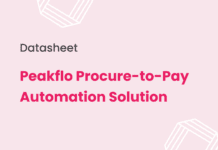Different industries and companies utilize different types of budgets. Finding the budget that works best for you can ensure that your business runs smoothly. The perfect budgeting method can help maximize profits and keep your financials organized and optimized.
In this article, learn the different types of budgeting strategies businesses can use. With the help of automated financial services from Peakflo, you can find the budgeting style that fits your business best.
What Is A Budget?
A budget is an organizational tool that businesses use to plan expenditures, track income, and increase awareness of financials. It is a financial plan that outlines the expected revenues and expenses of an individual, a business, or an organization over a specific period of time. It is typically created for a year, but can also cover shorter or longer periods. Budgets serve several purposes, including:
- Planning: It helps in planning future operations and activities based on expected income and expenditure.
- Control: It provides a benchmark against which actual financial performance can be measured and controlled.
- Communication: It communicates financial goals and priorities to stakeholders, such as management, investors, or creditors.
- Evaluation: It helps in evaluating the performance of an entity by comparing actual results with the budgeted figures.
- Decision Making: It assists in making informed decisions regarding resource allocation and investment opportunities.
There are different types of budget, and choosing the right one will help businesses stay organized and maximize financial decisions throughout the fiscal year.
What is Budgeting?
Budgeting involves creating businesses budgets to estimate the necessary funds required to operate successfully.Department heads use these budgets to set financial goals and ensure that allocated funds are used efficiently.
Finance teams and department heads set budget limits to monitor spend. If the allocated budget is insufficient, department heads informs the budgeting team with supporting reports. The budgeting team reviews these reports to decide whether to adjust the budget.
It’s important to keep budgets flexible to encourage creativity and explore alternative solutions. Rigid budgets can limit innovation and flexibility in decision-making.
Importance of Budgets in Business
Budgeting is essential for businesses to achieve financial stability, growth, and long-term success. It provides a roadmap for managing finances effectively and making informed decisions in a dynamic business environment.
Businesses face uncertainties like economic shifts, social changes, and technological advancements. Budgeting plays a pivotal role in ensuring readiness for such unforeseen events. By setting aside funds in a general reserve, companies can mitigate the risk of using operational funds during emergencies.
Budgeting is also instrumental in securing funding. Cash management reports, including budgets and cash flow statements, showcase company’s financial discipline and strategy which is crucial for potential investors.
Moreover, budgeting helps companies achieve their financial objectives by setting realistic goals aligned with available resources. It establishes spending boundaries, ensuring funds are used efficiently. Additionally, budgeting enhances planning by providing a clear picture of available monetary resources. This aids management in making informed decisions that align with their financial capabilities and do not adversely impact other budgetary allocations.
Budgeting fosters clarity and focus within an organization. It helps identify areas of overspending or unnecessary expenses, allowing management to take corrective actions. By understanding expenditure patterns, management can address issues like overlapping activities between departments, late payments, and penalties, leading to better financial management and operational efficiency.
Different Types of Budgets
Here are the types of budgeting methods to streamline your financial management:
1. Zero-Based Budgeting
Zero-based budgeting is a budgeting strategy that assumes that every financial period begins at $0. Each expected expense is tracked on a granular level until the budget is completely expended.
Zero-based budgeting is great for businesses that have specific spending goals. This model allows you to see how every dollar is allocated and usually includes a justification for each spent cent.
Businesses can easily see where money can be saved because of the level of detail in this model. The only downside to this style is that it can be extremely time-consuming and requires a large amount of data to properly allocate funds based on expected expenditures.
2. Incremental Budgeting
One of the most adopted types of budgeting is incremental budgeting. It uses the budget of the previous fiscal year and increases or decreases potential spending by a set increment.
If an area of the budget is overspent or underspent during a fiscal period, an incremental budget can just adjust the budget to account for this miscalculation for the next fiscal period.
For example, if a portion of the budget is allocated $250,000 for operations over a fiscal period, but the operations end up costing $300,000, the budget is then adjusted by an increment of $50,000 in the following fiscal period.
Incremental budgeting is beneficial because it makes it easy to use the same general master budget for every fiscal period. The budget will become more and more efficient and accurate with every fiscal period as the increments of spending are changed until the exact spending need is covered.
As the specific portions of the budget increase each year, it is easy for the management to see where spending habits need to be addressed.
One of the major drawbacks of incremental budgeting is that departments may feel the need to overspend to ensure they do not miss out on possible funding during the next fiscal period. If every department does this, your entire business will be massively overspending because no department wants its budget cut.
3. Activity-Based Budgeting
Activity-based budgeting is a budgeting style that organizes spending and revenue by the activities that they are tied to. Activity-based budgeting is a great way for companies to manage and monitor cash flow from each activity.
Activity-based budgeting is a great option for businesses that have a wide variety of products or services and wants to have a clear way to measure the cost and revenue of each one.
This budgeting style is beneficial for businesses that want to bolster their bottom line by managing the activities performed during each fiscal period.
Activity-based budgeting can help businesses decide which of their ventures are most profitable and which are costing more than they are earning. The only downside to activity-based budgeting is the amount of time, data, and training needed to efficiently create and manage this budget.
4. Value-Proposition Budgeting
A value proposition budget allocates funds to the portions of the budget that are going to provide the business with the most value. Value-proposition budgeting is all about putting the most money into the areas that will provide the company with the most return on investment. This may include market research, developing new products, or marketing.
Value-proposition budgeting is beneficial to businesses that are looking to increase revenue by investing in themselves.
For companies looking to meet their goals and increase profits quickly, a value-proposition budget can free up funds for marketing initiatives or business decisions that can help increase revenue. This style of budget can reduce operating expenses by allocating more money to the value proposition.
This style of budgeting can be extremely risky if the value proposition is miscalculated or simply unlucky. If a company budgets a large number of funds on an initiative they think will increase revenue, and it does not, or it costs more than expected, businesses can lose money quickly.
5. Flexible Budgeting
Much like the name suggests, a flexible budget is designed to be flexible to a company’s needs. Flexible budgets plan for a range of possibilities with each activity that helps account for changes in costs and revenues.
Flexible budgeting allows businesses to make changes to the budget within a financial period to reflect the needs of the business. If a certain department of initiative requires more spending than originally thought, a flexible budget can change to reflect the needed funds.
Flexible budgets are ideal for businesses that need to be super responsive to the market. If you work in a volatile industry where costs are constantly changing, a flexible budget can help you make the changes you need to access the funding you need when you need it.
The major downside of flexible budgeting is that it may promote irresponsible spending. Instead of budget managers addressing overspending, flexible budgeting allows departments and budget managers to change the budget rather than address the increased spending.
Flexible budgets can also be harder to track in real time. A current expenditure may increase, taking away possible budget space from another area.
Manage your Business Budgets with Peakflo
Now you’ve learned that there are different types of budget, from zero-based to flexible budgeting, that businesses can adopt to streamline their management accounting.
Peakflo is your business’s one-stop shop for easy-to-use financial tools that make managing money a breeze. Peakflo’s Budget Management tools can help you find the budgeting style that is ideal for your business.
Peakflo lets you create different types of budgets with a few easy clicks. Our tools give you an easy way to manage your budget, automate your accounts payable, and keep your finances organized so you can focus on what’s most important; growing and running your business.
FAQ
How can a budget help an organization identify areas to save costs?
A budget helps organizations identify cost-saving opportunities by comparing actual expenses with budgeted amounts, highlighting areas of overspending or inefficiency.
What are common challenges to avoid in budgeting?
Common challenges to avoid in budgeting include making unrealistic revenue and expense predictions, not tracking expenses adequately, insufficient stakeholder involvement, and having a budget that is too rigid to accommodate changes.
How does budgeting support organizational growth and expansion?
Budgeting supports organizational growth and expansion by providing a framework for allocating resources effectively, identifying investment opportunities, controlling costs, and ensuring financial stability.
How does budget planning help organizations align financial resources with strategic priorities?
Budget planning helps organizations align financial resources with strategic priorities by guiding resource allocation toward key initiatives that support strategic goals, thereby enhancing overall performance and effectiveness.
Why is it important to regularly review and revise budgets?
Regularly reviewing and revising budgets helps organizations identify areas for improvement, address financial challenges, and adapt to changes in the business environment, maximizing the effectiveness of the budgeting process.









![Why AI Sales Calls Are Making Good Sales Reps Even Better [2025 Guide] ai sales calls](https://cdn-kmjmp.nitrocdn.com/YvtqmrsiHUxqerlSiZgbfzqqTARWTElr/assets/images/optimized/rev-834053b/blog.peakflo.co/wp-content/uploads/2025/09/65168cf6-3001-4733-8cbc-12d5684cf449-218x150.webp)

































